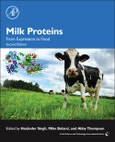Understanding of the interactions of milk proteins in complex food systems continues to progress, resulting in specialized milk-protein based applications in functional foods, and in protein ingredients for specific health applications. Milk Proteins is the first and only presentation of the entire dairy food chain - from the source to the nutritional aspects affecting the consumer.
With focus on the molecular structures and interactions of milk proteins in various processing methods, Milk Proteins presents a comprehensive overview of the biology and chemistry of milk, as well as featuring the latest science and developments. Significant insight into the use of milk proteins from an industry viewpoint provides valuable application-based information. Those working with food and nutritional research and product development will find this book useful.
- 20% new chapter content - full revision throughout
- New chapters address: role of milk proteins in human health; aspects of digestion and absorption of milk proteins in the GIT; consumer demand and future trends in milk proteins; and world supply of proteins with a focus on dairy proteins
- Internationally recognized authors and editors bring academic and industrial insights to this important topic
Please Note: This is an On Demand product, delivery may take up to 11 working days after payment has been received.
Table of Contents
1. World supply of food and the role of dairy protein 2. Milk: An overview 3. The comparative genomics of monotremes, marsupials and pinnipeds: Models to examine function of milk proteins 4. Significance, origin and function of bovine milk proteins: The biological implications of manipulation or modification 5. Post-translational modifications of caseins 6. Casein micelle structure and stability 7. Structure and stability of whey proteins 8. Effects of high pressure processing on structure and interactions of milk proteins 9. The whey proteins in milk: Thermal denaturation, physical interactions and effects on the functional properties of milk 10. Effects of drying on milk proteins 11. Changes in milk proteins during storage of dry powders 12. Interactions and functionality of milk proteins in food emulsions 13. Milk protein-polysaccharide interactions 14. Interactions between milk proteins and micronutrients 15. Model food systems and protein functionality 16. Sensory properties of dairy proteins 17. Milk protein gels 18. Milk proteins: A cornucopia for developing functional foods 19. Milk proteins and human health 20. Milk proteins: Digestion and absorption in the gastrointestinal tract 21. Milk proteins: Consumer demand and future trends








